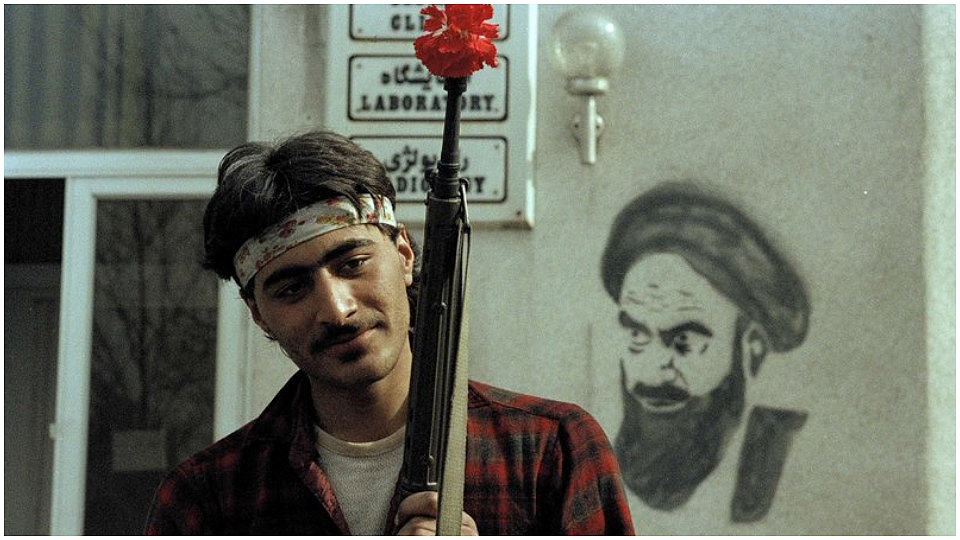
In the fall of 1978, massive waves of unrest and strikes—led largely by Iran’s oil workers—swept that country. By early 1979, the tyrannical government of Shah Mohammad Reza Pahlavi was pushed from power. The Revolution of February 1979 was the work of a wide range of class and social forces, united on a program of democracy and anti-imperialism. Within a short time, the Shi’ite religious fundamentalist groups around Ayatollah Khomeini that controlled the new government of the Islamic Republic, however, moved against the secular left revolutionary forces, particularly the Tudeh Party of Iran. By the early years of the 1980s, it was clear that the revolution had been betrayed. What follows are excerpts from articles printed in the Daily World, predecessor of People’s World, that cover developments in Iran as they happened. Most are written by Tom Foley, the Daily World’s chief correspondent on Iran for most of those years. For a perspective on Iran today, see People’s World’s interview with Mohammad Omidvar, a member of the political bureau of the Tudeh Party.
On Iran: Much is told, more is omitted
Tom Foley | May 9, 1969
The Shah owes his throne to the CIA and the oil companies. There is an army of police spies in Iran, trained by former New Jersey State Police chief Norman Schwarzkopf. There are probably more than 20,000 political prisoners…in the shah’s dungeons. American diplomats in Iran told me they had spotted at least five separate prisons for political offenders in trips around the country.
I saw the Shah’s U.S.-trained paratroops go into Tehran University in January 1962 and, under his orders, kill, maim, and rape students and then beat up the few brave doctors who came to tend the injured. I also remember the American officials who laughed about it and said, “They were probably all Communists anyway.” I did notice that the blood sprayed on the ceilings after the paratroops finished clubbing and trampling the students was red, but it had not occurred to me that this was an indication of political allegiance….
The Iranian Tudeh Party was the main anti-imperialist force in Iran up to 1953, and in that year was the prime target of the CIA, the Shah, and the oil companies. It was the Tudeh Party that organized and led over 400,000 Iranian workers, including all the oil workers, in Iran. It had a military section composed of hundreds of progressive Iranian army officers…. At least half the Iranian intelligentsia was in its ranks, while most of the other half followed its leadership.
Since 1953, the Tudeh has been subjected to especially fiendish persecution, but it is still there as an active force among Iran’s workers and peasants.
Crises mount for Shah’s regime
Tom Foley | November 9, 1979
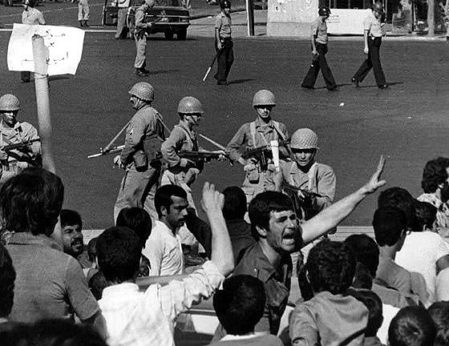
Food and fuel supplies in Iran’s major cities were running out fast on Wednesday as strikes began to choke the Shah’s dictatorial regime. The new military government of Gen. Gholam Reza Azhari late Tuesday made important concessions to Iran’s 40,000 striking oil workers by arresting Gen. Nematollah Nasiri, former chief of the dread SAVAK secret police agency, and over 50 other notorious Shah henchmen.
It seemed doubtful to most observers that the arrests would check the surging anti-Shah strike movement…. [but] the facts argued against transforming the struggle into a military one: The Shah’s forces are armed to the teeth by the U.S. and capable of reducing any Iranian city to smoking rubble. The anti-Shah forces have no arms to speak of and are relying on mass strike actions, not guns and bullets.
International news comments drew comparisons between the Shah and Tsar Nicholas II of Russia, sometimes referred to as “Nicholas the Last,” whose fall was brought about by angry women who started a riot in a bread line in Petrograd in February 1917. That was the end of the tsars, but only the beginning of struggle in Russia.
Shah reaches Egypt in flight to U.S.
Tom Foley | January 17, 1979
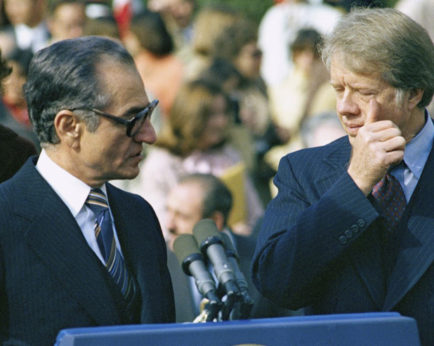
The Shah of Iran arrived yesterday in Aswan, Egypt, on his way to the U.S. after 13 months of mass demonstrations against his rule. It was the political strike of Iran’s 67,000 oil workers that forced the Shah in the end to slink out of the country.
Overjoyed Iranians flooded Tehran’s streets as they learned of the Shah’s departure. The laughed, cheered, wept, danced atop cars, blew car horns, tossed flowers and candy, and waved portraits of exiled Iranian Shi’ite Muslim leader, the Ayatollah Ruhollah Khomeini. They also pulled down the statue of Reza Shah, the Shah’s father and founder of the Pahlavi dynasty.
The U.S. capitalist news media, in an obvious effort to stir sympathy for the Iranian tyrant, said that the Shah “wept openly” as he left Iran. His personal fortune is estimated at between $3 billion and $23 billion, much of it stashed away abroad, so he is not going to suffer financial hardship.
As many as 10,000 Iranians—men, women, and children—may have been killed in the Shah’s vain attempt to crush the past 13 months of strikes and protests, and there are an estimated 25,000 to 100,000 political prisoners in the Shah’s jails.
In Paris yesterday, Ayatollah Khomeini greeted news of the Shah’s departure. He is expected to go back to Iran within the next week. The Shah-appointed government of Premier Shahpur Bakhtiyar is given no chance to survive and may crumble in a few days.
Khomeini returns, warns of U.S. pro-Shah plot
Tom Foley | February 2, 1979
The Ayatollah Ruhollah Khomeini made a scorching attack on U.S. imperialism yesterday on arrival in Tehran after 15 years in exile…. In a speech at Tehran’s Beheshte Zehra cemetery, where over 1,500 of his slain followers lie buried, Khomeini said the U.S. was plotting to put Mohammed Reza Pahlavi back in power, “but,” he declared, “we will not let the U.S. bring the Shah back.” He charged U.S. imperialism with plundering Iran and with using thousands of “advisers” to help the Shah kill, torture, and oppress the Iranian people….
Khomeini said he would appoint a revolutionary council to administer the country until democratic elections can be held for a constituent assembly to draw up a new constitution for Iran. Earlier, he said that the council and the government will not be composed primarily of Muslim clergy and that he will not be a member. He called for unity among all Iranian forces opposed to the Shah and fighting for democracy.
Iranian revolution moving ahead
Tom Foley | February 10, 1979

NEW YORK—Mehdi Bazargan, head of Iran’s provisional government, said Friday: The Shah’s departure was only the beginning. Today is the start of Phase Two of the revolution.” Bazargan urged the Shah-appointed Premier, Shahpur Bakhtiyar, to resign immediately and hand over power to the provisional government. He stressed that the Bakhtiyar regime is completely isolated and has no popular support.
The program of the provisional government consists of six points: 1.) transfer of power from Bakhtiyar regime to the provisional government; 2.) a popular referendum on Iran’s state system; 3.) reorganization of the power structure in Iran; 4.) elections for a constituent assembly; 5.) drafting of a new Iranian constitution; 6.) formation of a new government….
Bazargan, 73, a leading member of the National Front, is an engineer and head of the National Iranian Oil Company under former Premier Mohammed Mosaddeq. The Soviet news agency TASS said his appointment as head of the provisional government “is receiving the broadest support throughout Iran… The Iranian press notes that Bazargan is a bourgeois democrat who upholds Iran’s independence, stands for scrapping the monarchy and creating a non-aligned Islamic republic.”
Iran CP says: Expel U.S. ‘advisers’
Tom Foley | February 15, 1979
The Tudeh (“Masses”) Party of Iran on Wednesday demanded that the Shah, members of his family, and closest aides be brought to trial for their crimes against the Iranian people. In a statement released in Paris, the Tudeh Party said that all U.S. advisers should be expelled from Iran and that all military pacts concluded by the Shah should be annulled.
The Tudeh Party was formed in 1941 out of the old Communist Party of Iran and is Iran’s sole Marxist-Leninist party. Top U.S. officials have admitted they fear the Tudeh Party’s considerable strength among Iran’s oil workers.
Nureddin Kiyanuri, first secretary of the Tudeh Party, said, “The whole Iranian people have risen in struggle against the bankrupt monarchy, for a republic and for democratic rights, against imperialist domination, to save Iran’s oil from the U.S. and British imperialists, and to annul Iran’s military agreements with the U.S. and Britain.”
Shah’s wealth nationalized in Iran
Tom Foley | February 17, 1979
The Iranian government Friday confiscated all property of the Shah and of members of his family, worth billions of dollars. The decree, adopted unanimously by the provisional government of Premier Mehdi Bazargan, applies to property both at home and abroad, including foreign bank deposits of over $20 billion.
The return to the Iranian people of the wealth created by them, which had been taken by force by the Shah, lays the foundations for a greatly expanded, genuinely nationalized sector of the Iranian economy. It is one of the most progressive measures taken thus far by the new government….
While the U.S. news media was doing everything possible to convince the U.S. public that chaos, anarchy, and civil war reigned in Iran, there was every indication that the situation in fact was being rapidly normalized. Khomeini, in a Friday morning nationwide radio broadcast urged members of the armed forces to resume their normal duties…and repeated his earlier statement that all strikes should end Saturday.
The end of the strikes should mean that Iran can begin putting its economic house in order…. The U.S., however, seems to be moving toward a complete break with the new Iran, including an economic boycott like that applied to socialist Cuba…. Underlying this is the feeling Washington officials have that the new Iran will cancel the 1954 oil concession agreement with the top U.S. and British oil monopolies. That agreement was signed after the CIA overthrew former Premier Mohammed Mosaddeq in 1953 and re-installed the Shah in power.
CIA’s reactionary ‘Moslem studies’
William Pomeroy | February 28, 1979
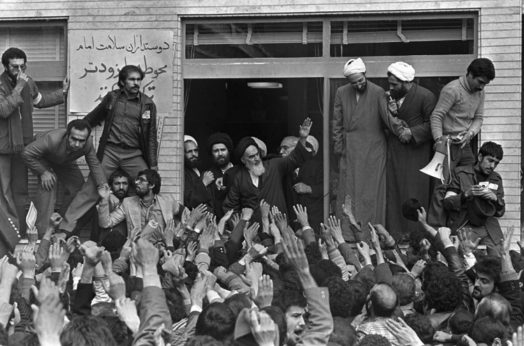
LONDON—It was reported on January 21 that…President Carter had ordered U.S. intelligence agencies to conduct a study of Moslem religious movements. This is to be undertaken, it was said, because an “Islamic revolt” had overthrown the Shah of Iran and U.S. intelligence agencies had been negligent in failing to pay attention to the Moslem factor in the Iranian revolution.
This brief report bristles with insinuations and implications. For one thing, it implies that the Shah and imperialist interests were the victims of a misunderstood religious movement, a movement moreover that allegedly opposed the Shah because he “tried to modernize” Iran.
In this aspect of the Carter Moslem line, the real causes of the anti-Shah revolt—brutal fascistic oppression related to neo-colonial control by imperialist multinational and military interests—and the real scope of the anti-Shah forces—a truly national movement cutting across class, social, and religious sectors—are to be blurred and confused. U.S. imperialism would thus hide its responsibility for the monstrous Shah regime and the revolution it created.
As for understanding Moslem religious movements, the U.S. government, its agencies, and the big corporations it serves have been dabbling long enough in Middle Eastern oil and in the affairs of those in whose soil it lies to understand perfectly well the Moslem beliefs and the Moslem way of life. It is well understood that class and national interests determine trends in the Middle East, and that Moslem or Islamic religious movements (of which there are many, as in the case of Christianity) reflect class and national conditions.
It doesn’t take much intelligence work to grasp the fact that it has not been a case of the Iranian people identifying themselves with the Shi’ite Moslem faith that overthrew the Shah, but of the Shi’ite Moslem leaders like Khomeini identifying themselves with the revolutionary cause of the Iranian people suffering oppression.
Iran Marxists urge revolutionary unity
Tom Foley | March 21, 1979
The Tudeh Party of Iran, in its most recent statement—the first issued in Tehran itself since the revolution—urged the unity of all forces taking part in the Iranian people’s revolution.
The statement declared the party’s support for Khomeini and for the creation of an Islamic republic.
It said: “The main condition for achieving the aims of the people’s revolution is the alliance of all forces taking part in the current revolutionary movement, regardless of their ideological, political, or philosophic views.”
Who speaks for Iranian women?
Eliza Bennett | March 21, 1979
Thousands of women marching in the streets of Tehran on International Women’s Day for their rights as women—for their right to dress as they please, what a beautiful sight!
Militant women asserting their rights as part of a revolutionary process after years of feudal oppression is a marvelous sight indeed. It invokes images of those women of the Soviet Far East who burned their thick horse hair veils in order to declare their path to liberation and support for their revolution….
[T]he original demonstration planned for March 8 in Tehran was to be a small affair, in honor of those women killed in the revolution. Ayatollah Khomeini’s suggestion on March 7 that women must cover themselves with the chador (a head to toe, loosely draped robe) in accordance with the Moslem tradition of modesty led to the enlarged demonstrations on the issues of dress and women’s rights.
Khomeini names Council to run Iran
Tom Foley | November 7, 1979
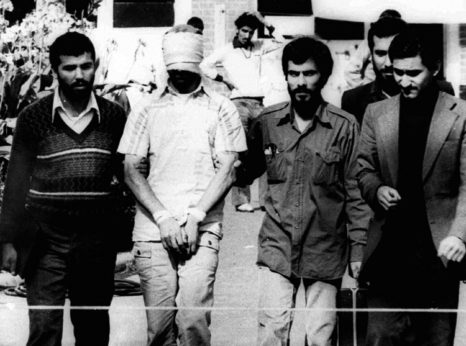
Khomeini yesterday ordered the Islamic Revolutionary Council to take over all governmental affairs following the resignation of Premier Mehdi Bazargan and his cabinet. At the same time, speculation grew in Tehran concerning the Revolutionary Council’s attitude toward last Sunday’s seizure of the U.S. Embassy by a group of students. The students continued holding 60 to 90 U.S. citizens as hostages in the Tehran Embassy. The State Department has flatly rejected their demand that the U.S. extradite the Shah to stand trial.
There was concern in many quarters that the seizure might be used by the Carter administration as an excuse for some sort of hostile, damaging action against the Iranian revolution. The students claim to be “Students Loyal to Khomeini,” although whether this is an organization’s name or a simple description is not clear.
The Foreign Ministry said the seizure of the U.S. Embassy was a “reaction to the fact that the American Administration ignores the demands of the Iranian people.”
Reagan blasted for remarks on Iran
Tim Wheeler | December 30, 1980
WASHINGTON—Leaders of the peace movement blasted President-elect Reagan today for inflaming the Iranian hostage crisis by referring to the Iranian people as “barbarians,” and to their demands as “ransom.” Reagan’s barrage has clearly risked torpedoing negotiations between the U.S. and Iran to win release of the 52 hostages, which have reached a delicate stage.
Islamic Republic of Iran closer to counter-revolution
Arash Alborzi | February 3, 1984
Religious and anti-Communist leaders, who have been promising national independence, freedom, and social justice to millions of Iranian toiling masses, finally gave in to pro-capitalist forces and betrayed the revolution. Now, their main concern is to stay in power and to export their version of “Islamic Revolution” at any cost.
In early 1983, the revolution’s top leadership, in a major political shift, chose dependent capitalism over national independence, repression over freedom, and capitalist exploitation over social justice. In this dangerous change of course they find the Tudeh Party of Iran, which has been the most persistent and ardent advocate of the revolution, to be a major obstacle. Consequently, an anti-Communist crusade became the dominant trend in the Islamic Republic’s domestic and foreign policy.
Meanwhile, all revolutionary reforms have been halted, and the political and economic ties with imperialist countries have expanded… McCarthyism is repeating in Iran, but under an Islamic cover. The Tudeh Party as pronounced “illegal” and “dissolved” by the “Revolution’s Prosecutor,” and all its members and leaders had to report to government officials within a month…more than 10,000 party members and supporters were arrested. Some were tortured to death.
Later on, Islamic Republic secret agents (ex-SAVAK agents) displayed a few party leaders on a contrived TV show, where, after previous severe psychological and physical torture, they “confessed” that they were Soviet agents and were selling reports at $15 each to Soviet authorities. Now Iran’s rulers have arranged secret courts martial to try Tudeh Party leaders and revolutionary army and navy personnel.
Iranian people, especially the working class, don’t believe the government’s propaganda. Instead, they lost confidence in the Islamic Republic’s authorities. During the past year, people have demonstrated their dissatisfaction…
The current policies of the Islamic Republic are paving the way for Iran’s complete return to imperialism’s camp. The U.S. is waiting, and planning, for the right moment to strike the crushing blow to the people’s revolution.
U.S. pushes Iran-Iraq war
Tom Foley | June 30, 1984
The war began on September 22, 1980, when Iraqi forces invaded Iran. The immediate objective of the Iraqi regime was to seize Iran’s chief oil-producing province, Khuzistan, where the country’s Arab minority lives. By holding Khuzistan, Iraq would have leaped into the front ranks of the world’s oil-producing countries…. All this meant Iraq needed little persuasion to start the war.
But the Iraqi regime’s interests dovetailed with those of U.S. imperialism, Israeli Zionism, and reactionary Arab regimes. They were all nervous about Iran. The 1979 revolution caused the downfall of the Shah’s regime, a regime built up by Washington to be its chief “security guard” in the Persian Gulf.
The aggressive interventionist, pro-U.S. imperialist policy of the Shah caused legitimate concern in neighboring Iraq in the 1970s. It was one of the reasons why the Iraqis got enough military aid from the USSR to at least defend themselves against a possible onslaught by the Shah.
But the Iraqi regime, particularly after Saddam Hussein became president, became increasingly rightist in orientation…. Washington and Tel Aviv may have felt that by mid-1980, the Iranian revolution was having a dangerous effect on pro-U.S. regimes in the Persian Gulf like Saudi Arabia. This is where Iraq stepped in….
The U.S. imperialists probably figured that no matter what happened, they could not lose. They might have a chance to install another Shah in Iran. They would hold off any Iranian threat to “their” oil in Saudi Arabia.
And in the meantime, two non-aligned Middle Eastern countries would be destroying each other. That the war would push the governments of both countries to the right was undoubtedly expected as well.
Slowly during the war, rightist elements gained the upper hand in Iran. The Tudeh Party has been outlawed, many of its members have been executed, working people’s living standards have deteriorated, there is a wage freeze despite continuing inflation, strikes are not allowed, and nearly the same old groups of big landlords and capitalists exert powerful influences in government…










